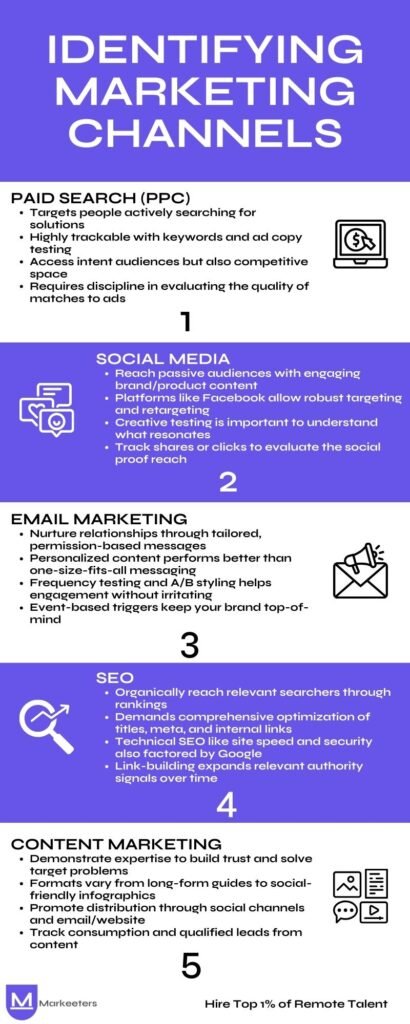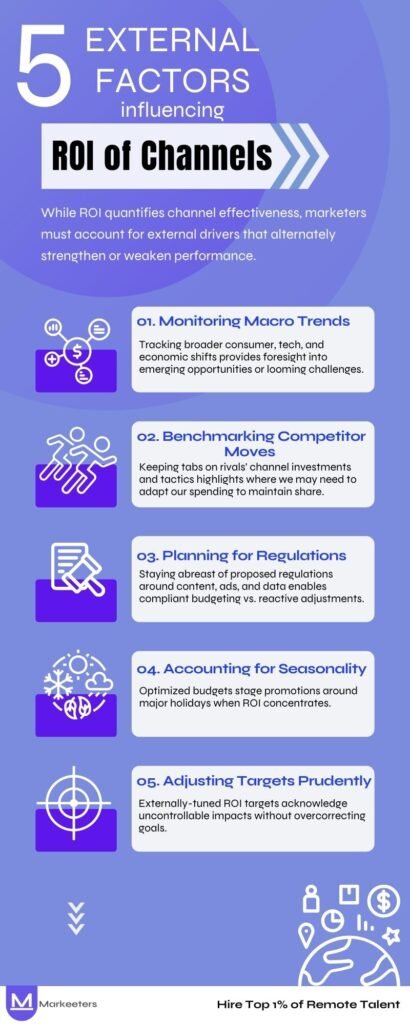As digital opportunities expand, marketers face welcome challenges – where to focus? With limited marketing budgets and countless channels vying for attention, prioritizing the proper channels is crucial for business success. Marketers must strategically allocate resources to drive the highest returns, yet determining the true ROI of each channel is complex. And that’s the critical question that all marketers face, “How to Prioritize Marketing Channels Based on ROI?“
We must target conversions, not clicks. While splashy ads grab attention, true ROI delivers ripple effects long-term through positive experiences and word of mouth.
In this post, we will cover:
- The fundamentals of marketing ROI
- Calculating overall marketing and channel-specific ROI
- Applying the 80/20 principle to channel strategy
- External factors that influence channel efficiency
- A step-by-step framework for ROI-driven channel prioritization
Why ROI Rules the Marketing World?
Return on investment (ROI) reveals the profits generated relative to costs expended on campaigns and channels. By quantifying the financial returns, ROI enables data-driven budget optimizations.
The ROI Formula
Marketing ROI is expressed as:
ROI (%) = (Net Revenue – Total Costs) / Total Costs x 100
For example, a $100k campaign yielding $150k net revenue calculates to:
($150k – $100k) / $100k x 100 = 50% ROI
Why Marketers Value ROI
Several strategic factors make carefully tracking and optimizing ROI a crucial priority for marketing decision-makers:
Highlights Top Performers
ROI analysis broken down by individual channels, campaigns, and tactics provides critical insight into where budgets deliver the strongest returns. With this knowledge, marketing leaders can confidently increase investments in high-ROI areas to further amplify impacts and profits over time.
Uncovers Inefficient Efforts
Conversely, consistently underperforming channels or initiatives signal where current spending may be exceeding the value captured. By redirecting funds away from low-ROI programs, marketing saves budgets to inject into proven performers.
Enables Benchmarking
Adopting consistent ROI measurement allows marketing to gauge progress against past performance as well as evaluate results relative to competitors and industry benchmarks. This facilitates goal-setting, tracking KPI movement, and optimizing strategies accordingly.
Builds Executive Support
By quantifying marketing’s tangible economic impacts, ROI metrics function as an instrument for gaining approval and justification of necessary budgets. Financial proof points appeal strongly to C-suites.
Informs Continuous Improvement
Granular ROI analyses reveal nuanced learnings that can then guide strategic refinements to messaging, product promotion, creative testing, and beyond – helping marketing systematically lift returns on each dollar spent.
Instills Financial Accountability
Focusing on ROI instills financial responsibility and prudence throughout budget planning and channel/campaign execution for marketing.
Measuring Overall Marketing ROI
Deriving the complete ROI figure involves summing investments across every marketing activity and attributing total profits earned to those collective efforts.
Determining Total Marketing Expenses
Compile costs over a 12-month business period across all expense categories contributing to marketing efforts, including:
- Labor expenses like salaries, bonuses, and overhead for internal marketing staff
- Program production and delivery costs for campaigns, events, and initiatives
- Digital, print, TV, and radio advertising media investments
- Technology costs such as website hosting, MARTECH tools, analytics subscriptions
- Internal systems and databases supporting marketing operations
- Consulting fees paid to external creative and strategic agencies
- Tradeshow, conference, and industry event participation fees
- Materials production and distribution expenses for collateral
- Travel costs enabling business development meetings and industry conferences
- Depreciation amounts for hardware, software, and other capital assets
The goal is to capture all financial outlays—both direct costs and an attributable share of overhead expenses—supporting marketing activities over the timeframe.
Also Read: Digital Marketing vs. Growth Marketing: Which Strategy Should You Choose?
Determining Marketing’s Profit Impact
Gauging the revenue attributable to marketing requires tracing campaigns and channels throughout the customer decision process. Consider these analytical techniques:
- Leverage CRM for lead sourcing data, sales pipeline influences, and multi-touch conversions originating from various promotions
- Implement URL tagging and tracking codes to attribute on-site conversions to precise marketing efforts
- Employ multi-touch attribution modeling to apportion conversion credit across all relevant touchpoints in consideration of customer journeys
- Administer surveys and interviews to gain qualitative customer insights into the role various promotions played in their purchase decisions
- Collaborate with sales teams to assess marketing’s contribution to lead qualification, opportunities created, and overall deal closure rates
- Analyze pre/post “Year-Over-Year” sales variances linked to campaign rollouts
Such in-depth analyses map how marketing activities and touchpoints ultimately contributed to revenue by determining their role in moving prospects through journeys culminating in closed-loop sales. Calculate true profits by discounting operational expenses like production, fulfillment, R&D, and administration costs from attributable marketing revenues.
Calculating the Overall ROI Figure
By this stage, the total marketing investment amount and revenues attributable to those efforts over 12 months have been determined. To calculate the overall ROI:
ROI = (Attributed Revenue – Total Investment) / Total Investment x 100
This final equation expresses total marketing profitability by accounting for costs versus profits generated.
The resulting percentage showcases the efficiency and demonstrable value of all collective marketing activities over the analyzed timeframe.
Whilst the holistic ROI view carries significance, optimizing resource allocation demands drilling deeper. Analyzing channel-specific ROI business cases enables pinpointing where dollars most efficiently drive returns to refine budget priorities moving forward.
The overall ROI equips leadership with a high-level assessment of marketing productivity, yet granular channel ROI fosters actionable optimization through go/no-go spend decisions and targeted reinvestment into proven marketing programs and mediums.
Identifying Marketing Channels
Here are some key marketing channels and how they contribute:

Paid Search (PPC)
- Targets people actively searching for solutions
- Highly trackable with keywords and ad copy testing
- Access intent audiences but also competitive space
- Requires discipline in evaluating the quality of matches to ads
Social Media
- Reach passive audiences with engaging brand/product content
- Platforms like Facebook allow robust targeting and retargeting
- Creative testing is important to understand what resonates
- Track shares or clicks to evaluate the social proof reach
Also Read: Top 10 Best Social Media Platforms for Freelancers 2023
Email Marketing
- Nurture relationships through tailored, permission-based messages
- Personalized content performs better than one-size-fits-all messaging
- Frequency testing and A/B styling helps engagement without irritating
- Event-based triggers keep your brand top-of-mind
SEO
- Organically reach relevant searchers through rankings
- Demands comprehensive optimization of titles, meta, and internal links
- Technical SEO like site speed and security also factored by Google
- Link-building expands relevant authority signals over time
Content Marketing
- Demonstrate expertise to build trust and solve target problems
- Formats vary from long-form guides to social-friendly infographics
- Promote distribution through social channels and email/website
- Track consumption and qualified leads from content
Calculating ROI by Marketing Channel
Tallying Channel Costs
Account for all expenses directly attributable to each marketing channel, including:
- Paid advertising or promotion costs
- Campaign production and management
- Technology platforms and tools
- Agency fees
- Internal staff time and resources utilized
- Allocated overhead like office space and software subscriptions
Factor both direct and indirect costs and be comprehensive.
Attributing Channel Profit
Leverage analytics, modeling, and data to assign revenue value to each channel. This quantifies each channel’s contribution to overall profit. Methods include:
- Multi-touch attribution – Splits credit among different touchpoints that influenced conversions
- Algorithmic modeling – Statistically estimates the impact of each channel
- Campaign source tracking – CRM coding that tags lead/sales by originating channel
- Marketing mix modeling – Models the revenue driven by channel variables
- Heuristic modeling – A rules-based model that assigns channel credit
These analysis inputs enable calculating profit by channel.
Calculating Channel ROI
With costs tallied and profit attributed, simply plug figures into the formula:
Channel ROI= (Channel Revenue-Cost Incurred) / Cost Incurred
Comparing ROI by channel provides a clear insight into spending efficiency. Now let’s unpack lessons for channel optimization.
Must Read: SEO Freelancer vs. In-House SEO vs. SEO Agency
The 80/20 Rule in Marketing
When allocating budgets based on ROI, Pareto’s 80/20 principle often emerges:
80% of outcomes are driven by 20% of inputs or causes.
For marketing, this means 20% of channels often drive around 80% of conversions, revenue, and profit. The exact ratio varies, but the takeaway is clear – a small subset of channels produce outsized impact.
This phenomenon surfaces because most brands spread budgets too thinly across a proliferating array of channels. This dilutes ROI.
Analyzing channel ROI helps identify and double down on the 20% driving the lion’s share of results. Trimming investment in the lagging 80% of channels and reallocating it to the vital 20% significantly increases overall marketing ROI.
Let’s illustrate the 80/20 concept with some examples:
Example 1
- Total Marketing Budget: $500,000
- Top 20% Channel by ROI: Paid Search
- Paid Search ROI: 250%
- 80% of Budget to Paid Search: $400,000
- ROI from $400,000 Paid Search Spend: $1,000,000
Example 2
- Total Budget: $800,000
- Top 20% Channel: Social Media Ads
- Social Media ROI: 210%
- 80% of Budget to Social Ads: $640,000
- 210% ROI from $640,000 = $1,344,000
This illustrates the power of focusing the budget on the 20% of high-ROI channels versus spreading thinly across all channels.
Now let’s explore external dynamics beyond your control that sway channel ROI.
External Factors Influencing Channel ROI

While ROI quantifies channel effectiveness, marketers must account for external drivers that alternately strengthen or weaken performance:
Monitoring Macro Trends
By tracking broader consumer, technological, and economic shifts, we gain foresight into emerging opportunities or looming challenges. For instance, the work-from-home movement has boosted online spending but also competition there. Factoring forecasted trends into ROI analyses prevents lagging or losing focus on developing spaces.
Benchmarking Competitor Moves
Keeping a close watch on rivals’ channel investments, innovative tactics, and relative performance highlights where we may need to similarly adapt spending to maintain market share or pilot tests of new initiatives. Leading rather than reacting serves us better.
Planning for Regulations
Privacy laws like CCPA have intensified data requirements and strain channel costs if not addressed proactively. Staying abreast of proposed regulations around content, ads, and data empowers compliant budgeting instead of costly reactive adjustments.
Accounting for Seasonality
Major holidays and back-to-school seasons tend to concentrate on ROI. Optimized budgets stage promotions accordingly or leverage less peak-oriented channels as alternatives. The year-round performance receives a clear picture.
Adjusting Targets Prudently
Externally-tuned ROI targets acknowledge uncontrollable impacts yet avoid overcorrecting to unreachable goals. Stretch benchmarks still incent healthy performance without setting unrealistic expectations that demotivate teams.
Tracking industry, economic, and environmental fluctuations furnishes vital context regarding ROI variances. This sensitivity allows marketers to judiciously set channel mix targets resilient to outside disrupters.
Accounting for external impacts in this manner builds flexibility into strategic planning for optimizing promotion budgets through inevitable changes.
A Strategic Framework for Channel Prioritization
The following process allows marketing teams to methodically prioritize channels based on projected ROI, strategic value, and operational requirements:
Define SMART Goals
Cross-functional workshops are held to identify 2-4 quantifiable objectives for the next fiscal year. Goals must be specific, measurable, attainable, relevant, and time-bound to provide clear guidance and evaluate success. Metrics like leads, conversions, or revenue targets focus efforts.
Calculate Historical Channel ROI
Granular performance data spanning 12-18 months is extracted from analytics systems. Metrics comparing costs to leads, conversions, or profits are standardized to normalize comparison. Data is cleaned to remove anomalies and adjust for seasonality effects to reveal typical past ROI levels.
Project Future Channel ROI
All planned marketing initiatives, audience expansions, or creative tests are reviewed to estimate their likely impact on key metrics and ROI. Benchmarking also accounts for predicted shifts in the competitive landscape, customer preferences, and macro factors. Projections provide estimated ROI ranges considering uncertainty.
Assess Strategic Value
Departments collaborate in surveys to rank the strategic importance of goals each channel can impact, like new customer acquisition versus retention. Scoring systems prevent an over-reliance on ROI while ensuring alignment with overarching business strategy.
Audit Resource Requirements
A comprehensive review determines the financial and staffing expenses required to efficiently operate each channel at scale. Budgets, headcounts, technologies, skillsets, and specialized contracts are quantified. Setup costs for debut efforts are also included to fully scope needs.
Calculate Priority Scores
A weighted model prioritizes channels by numerically synthesizing ROI projections, strategic importance ratings, and quantified resource cost factors. Weightings emphasize factors prioritizing future opportunities over historical data.
Create Investment Tiers
Channels are sorted into ranked categories – usually A, B, and C tiers – based on their overall priority scores. Tiers guide the strategic allocation of funding, staff time, and focus over the next 6-12 months to optimize the promotion mix.
Reallocate Budgets
A staged reallocation transition occurs, shifting percentages of budgets from lower to higher-tier channels in prudent increments over multiple periods. This allows previously focused areas to be optimized before ramping down to reduce business risks.
Continuously Refine
The entire process undergoes biannual reviews. New data and external factors prompt score recalculations and tier adjustments. Continuous tracking measures the ROI impact from changes to guide future optimizations.
This methodology aligns channel investments tightly to strategic goals, projected ROI, and operational constraints for optimized efficiency. Now let’s examine it in action.
Channel Prioritization Strategy Examples
Here are two examples of B2B companies implementing an ROI-driven channel prioritization framework:
SaaS Company Approach
This software firm analyzed historical performance and set the following 12-month goals:
- Boost free trial sign-ups by 30%
- Increase conversion rate from trial to paid plan by 20%
- Improve customer retention rate by 10%
Based on ROI analysis, channels were scored on expected ROI, strategic value, and resource requirements:
| Channel | Expected ROI | Strategic Value | Resource Needs | Priority Score |
| Content Marketing | 180% | 5 | 3 | 300 |
| Paid Search | 210% | 4 | 4 | 210 |
| Webinars | 150% | 3 | 3 | 150 |
| Print Advertising | 110% | 1 | 2 | 55 |
Manufacturing Company Approach
This B2B manufacturer established the following 12-month goals:
- Increase website traffic by 15%
- Grow lead conversion rate by 30%
- Improve customer retention rate by 10%
The analysis revealed:
| Channel | Expected ROI | Strategic Value | Resource Needs | Priority Score |
| SEO | 250% | 5 | 3 | 417 |
| Email Marketing | 180% | 4 | 2 | 360 |
| Social Media | 140% | 3 | 4 | 105 |
This framework enables strategic, data-backed channel prioritization tailored to business goals. Now let’s discuss bringing the channel strategy to life.
How to Prioritize Marketing Channels Based on ROI

With budgets reallocated based on the channel prioritization framework, effectively executing the strategy is critical for success:
Phase 1: Planning
- Establish specific ROI, revenue, and KPI targets for each channel based on goals and budgets.
- Document integrated plans detailing strategies, resource needs, timelines, and contingencies.
- Confirm analytics and attribution modeling approaches to track channel profitability.
- Ensure reporting tools are in place to monitor KPIs.
- Develop agile workflows to adjust initiatives rapidly based on performance data.
Phase 2: Implementation
- Gradually shift channel budgets over 6-12 months based on priority framework.
- Ramp up essential staff, technology, and capabilities needed to deliver on channel plans.
- Create and distribute optimized content tailored to each channel’s audience and objectives.
- Build workflows and automation to streamline channel operations and analysis.
Phase 3: Continual Optimization
- Rigorously monitor channel KPIs including ROI, traffic, conversions, and engagement.
- Make tactical adjustments to initiatives, content calendars, and asset allocation based on data.
- Every 6 months, update channel priority tiers based on new ROI figures.
- Shift budgets from lower-tier channels to emerging high-ROI opportunities.
- Keep abreast of market trends that may impact channel performance.
Ongoing agility, learning, and optimization will maximize returns from your channel investments over time.
Key Takeaways and Next Steps
Here are the prime conclusions from reviewing our channel optimization framework:
Numerically evaluating past and projected ROI by standardized metrics establishes performance benchmarks to maximize future value.
Combining ROI data with strategic fit and operational realities quantifies investment priorities to focus dollars where opportunities yield the strongest returns.
Continuous tracking and biannual reassessments capture evolving dynamics, ensuring budgets fuel top opportunities as landscapes change over time.
Optimization empowers the demonstration of marketing’s measurable impact while extracting added impact from constrained budgets through prudent reallocation.
Implementing this systematic process provides an evidence-based method for transparently evaluating channel efficiency, showcasing ROI achievements, and keeping the promotion mix tightly aligned with strategic objectives.
FAQs on How to Prioritize Marketing Channels Based on ROI
What are the 6 C’s of channel strategy?
Strong channel strategies are crucial for marketing success, so let’s explore the Six C’s model used to develop these blueprints:
1. Content: What types of messages map best to each outlet? Consider the appropriate format, tone, and frequency by channel.
2. Community: Leverage platforms where your audience congregates naturally. Opportunities exist within affinity groups across channels.
3. Commerce: Align channels conducive to each stage of the buying cycle. Some drive awareness while others suit transactions best.
4. Conversations: Certain channels like review sites and social platforms lend well to discussions. Foster two-way dialogues strategically.
5. Connections: Consider channels that expand your network through warm introductions like coworking communities or industry events.
6. Consistency: Cohesive branding, language, and call-to-actions unify the customer experience over all touchpoints.
What is an ROI-driven marketing strategy?
An ROI-driven marketing strategy involves selecting tactics that can demonstrate a clear return on investment. The goal is to allocate budgets to initiatives with quantified impacts on key performance metrics.
Some defining characteristics of ROI-focused strategies include:
• Establishing measurable marketing objectives tied to revenues, leads, or other business goals beforehand.
• Utilizing analytics tools to track ROI metrics like cost per acquisition or lead across each campaign.
• Prioritizing channels, content, and programs that consistently prove cost-effective relative to desired outcomes.
• Testing new approaches through limited launches and A/B testing to validate ROI before scaling fully.
• Continually optimizing based on learnings from previous performance data.
• Integrating budgets, planning, and reporting tightly with sales to align on mutual definitions of success.
What is the ideal number of marketing channels?
There’s no single ideal number of marketing channels, as the optimal mix depends entirely on your unique audience and objectives. However, here are a few best practices we’ve observed:
• Focus on your top 2-3 channels where your buyers congregate most. Don’t dilute efforts across too many platforms.
• Campaigns using 3-5 carefully selected channels that synergistically support each other often see the best results. For instance, pairing SEO with content marketing.
• Staying within 5-7 top channels allows sufficient concentration without missing major touchpoints. Beyond that, coordination gets unwieldy.
• Test new channels selectively based on client needs rather than just jumping on every latest trend. Validate fit first.
• Maintain at least 2 paid, 2 owned, and 2 earned media channels in your portfolio for balanced promotions.
• As you scale, decentralizing channels regionally under a hybrid structure could expand your total while keeping per-office counts lower.
Ultimately, choose only channels aligning with customer journey stages, buyer personas, and marketing goals. Fewer tailored channels executed exceptionally usually triumph over trying too many halfheartedly.
What is Channel prioritization?
Channel prioritization refers to the process of evaluating your different marketing channels and determining which ones to focus resources and budgets on based on their ability to meet your business goals. Here are a few key aspects of channel prioritization:
• Analyze metrics: Review data on metrics like conversion rates, leads/sales generated, and costs per lead/action to understand each channel’s performance and ROI.
• Consider audience: Where your target customers spend their time online and off helps determine the best channels to reach them.
• Align to goals: Prioritize channels most effective for your desired outcomes like campaigns based on sales vs. awareness objectives.
• Balance types: Aim for a mix of owned, paid, and earned channels for well-rounded promotions.
• Test new channels: Pilot emerging options on limited budgets before scaling to validate fit.
• Optimize over time: Reassess channel rankings periodically as audiences and priorities shift.





